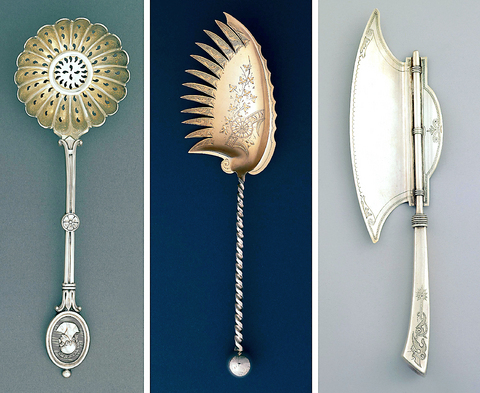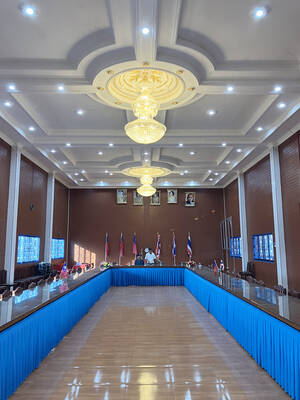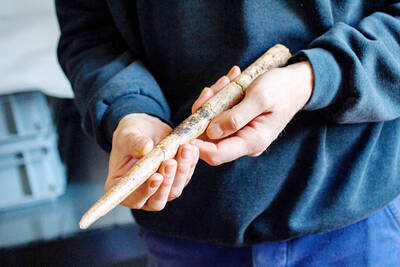I have seen dinner guests recoil from the offer of a silver fork, and resist when said fork was later dispatched to the dishwasher. But I refuse to be scared of using real silverware: Silver is strong stuff, and even when slightly tarnished, I like its warmth and heft.
But I'm in a shrinking minority: The number of American couples who register for sterling goes down every year, according to Caroline Baize of the Christofle silver company. "More couples want to save their money for a nice honeymoon," she said. Many of them may have already found themselves in custody of sterling silver that they consider "too good" for regular use.
But Feeding Desire: Design and the Tools of the Table, an exhibition of Western eating utensils opening May 5 at the Cooper-Hewitt National Design Museum in New York, may inspire people to use the good stuff.

PHOTO: NY TIMES NEWS SERVICE
In the paneled dining room of the old Andrew Carnegie mansion that houses the museum, visitors will gaze upon Renaissance-era utensils whose carved ivory handles are tiny religious masterpieces, Napoleon's traveling silverware, and modern upstart utensils like the spork and its relatives.
These items might sound trivial, even boring -- the culinary equivalent of a museum show dedicated to old blankets or early toothbrush designs.
But passionate defenders of this declining art form see the show as a chance to revive the stature it once had at the table.
"These are the tools that turned eating into dining" said Sarah Coffin, a curator at the museum who has been researching the subject for almost 30 years. "Today we seem to be moving in the other direction, toward everyone eating in their cars with their hands, so it's pure pleasure to spend time with these objects and realize how useful they are."
"The fork, knife and spoon are clearly perfect forms," Coffin said as she pulled out drawer after drawer of them, all polished and ready for their moment in the spotlight. "How many things we use today have been virtually unchanged for the last 400 years?"
Western utensils are relative latecomers: while the Romans were sticking shells onto sticks to make early spoons, the Chinese had already refined the use of chopsticks over thousands of years.
In the West, knives were the first tool to come to the table, as personal weapons that were also used for cutting and spearing meat. In the 1600s, the pointed tip of the knife was rounded by decree of King Louis XIII of France. Some historians say this was to prevent violence at the dinner table, others, to prevent unsightly tooth-picking by courtiers, a particular irritant to Cardinal Richelieu. If the knife was associated with the hunt and the manly act of stabbing, the spoon was maternal, used for soft gruels or to feed babies and the elderly.
"Spoons were originally round, but the advent of purees and smooth soups made a more oval shape more practical, to let you tip the liquid directly into the front of your mouth," Coffin said.
The fork, which came much later, brought with it associations of the Devil's pitchfork and the perceived effeminacy of the East; it was an 11th-century Byzantine princess who made its first recorded use in Europe, as a golden tool to prevent her fingers from getting sticky from candied fruit. Medieval Christians were frequently banned from using forks by the Church, and even Louis XIV, a monarch not known for his austerity, refused to eat with a fork because of its associations with his effete predecessor Henri III.
The triumvirate of knife, fork and spoon together was in common use in Europe by the end of the 1700s. All three pieces traveled from place to place with their owners -- often worn on the body in a kind of holster -- until the following century, when households began stockpiling utensils. This opened the door to flatware as a visible marker of wealth, developing patterns, crests, and flourishes that reflected on the household's stature and its taste.
And so we arrive at the late 19th-century sterling nut picks, strawberry spoons, and monogrammed terrapin forks on display at the Cooper-Hewitt, which seem like artifacts of a civilization as distant as Pompeii, not our own relatively recent Gilded Age. When Mark Twain gave that title to his 1873 novel, it was a caustic reference to the era's rampant corruption in business and politics, but it is also tempting to apply it to its culture of excess in flatware. "One service at the time had over 300 different pieces," Coffin said as we inspected an ornate gold-covered dessert service presented to J.P. Morgan by the understandably grateful directors of the New York Central Railroad.
Not only Morgans and Carnegies were caught up in the frenzy for flatware.
"There is something very touching about many of these pieces" said Annamarie Sandecki, the director of the Tiffany and Co archive, which loaned numerous pieces to the show. "We were such a young country, with no inherited wealth, no family silver. Buying silverware was a way to establish yourself as a person of substance."
Gilded Age designers brought Japanese influence and playful naturalistic decoration to the table, affixing tiny silver birds' nests with eggs to egg spoons and applying scalloped edges to scallop forks.
"This was one of the first art movements to start in America and then make its way to Europe," Coffin said.
In return, modern designers in Germany and Scandinavia stripped utensils down to their most unadorned. Throughout the process, designers have tinkered with the basic forms to see if they could be improved on or consolidated. The spork, according to Coffin, is probably the earliest innovation, but the Cooper-Hewitt show also includes knorks, knoons and even an intriguing utensil that can act as all three.

Taiwan Power Co (Taipower, 台電) and the New Taipei City Government in May last year agreed to allow the activation of a spent fuel storage facility for the Jinshan Nuclear Power Plant in Shihmen District (石門). The deal ended eleven years of legal wrangling. According to the Taipower announcement, the city government engaged in repeated delays, failing to approve water and soil conservation plans. Taipower said at the time that plans for another dry storage facility for the Guosheng Nuclear Power Plant in New Taipei City’s Wanli District (萬里) remained stuck in legal limbo. Later that year an agreement was reached

What does the Taiwan People’s Party (TPP) in the Huang Kuo-chang (黃國昌) era stand for? What sets it apart from their allies, the Chinese Nationalist Party (KMT)? With some shifts in tone and emphasis, the KMT’s stances have not changed significantly since the late 2000s and the era of former president Ma Ying-jeou (馬英九). The Democratic Progressive Party’s (DPP) current platform formed in the mid-2010s under the guidance of Tsai Ing-wen (蔡英文), and current President William Lai (賴清德) campaigned on continuity. Though their ideological stances may be a bit stale, they have the advantage of being broadly understood by the voters.

In a high-rise office building in Taipei’s government district, the primary agency for maintaining links to Thailand’s 108 Yunnan villages — which are home to a population of around 200,000 descendants of the Chinese Nationalist Party (KMT) armies stranded in Thailand following the Chinese Civil War — is the Overseas Community Affairs Council (OCAC). Established in China in 1926, the OCAC was born of a mandate to support Chinese education, culture and economic development in far flung Chinese diaspora communities, which, especially in southeast Asia, had underwritten the military insurgencies against the Qing Dynasty that led to the founding of

Artifacts found at archeological sites in France and Spain along the Bay of Biscay shoreline show that humans have been crafting tools from whale bones since more than 20,000 years ago, illustrating anew the resourcefulness of prehistoric people. The tools, primarily hunting implements such as projectile points, were fashioned from the bones of at least five species of large whales, the researchers said. Bones from sperm whales were the most abundant, followed by fin whales, gray whales, right or bowhead whales — two species indistinguishable with the analytical method used in the study — and blue whales. With seafaring capabilities by humans